The Effectiveness of Lifestyle Adaptation for the Prevention of Prediabetes in Adults: A Systematic Review
- PMID: 28567425
- PMCID: PMC5439262
- DOI: 10.1155/2017/8493145
The Effectiveness of Lifestyle Adaptation for the Prevention of Prediabetes in Adults: A Systematic Review
Abstract
Diabetes prevalence is increasing exceptionally worldwide and with this come associated healthcare costs. The primary outcome of this systematic review was to assess glycaemic control and incidence of Type 2 diabetes mellitus (T2DM) diagnosis after exercise and dietary intervention (measured with any validated scale). The secondary outcome assessed body mass index change, weight change, and physical exercise capacity after diet and exercise intervention (measured with any validated scale). 1,780 studies were identified from searching electronic databases. Relevant studies went through a selection process. The inclusion criteria for all studies were people with prediabetes diagnosed by either impaired glucose tolerance (IGT) or impaired fasting glucose (IFG). Lifestyle adaptation reduced the incidence of diabetes development more than standard treatment. Furthermore, better glycaemic control, improved physical exercise capacity, and increased weight reduction were observed with lifestyle intervention over standard treatment. Finally, improvements over the long term deteriorated, highlighting problems with long-term adherence to lifestyle changes. Overall, cumulative incidence of diabetes is drastically reduced in the intervention groups compared to control groups (standard care). Furthermore, glycaemic control was improved in the short term, with many participants reverting to normoglycaemia.
Figures
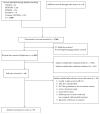
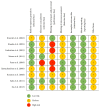
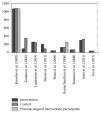
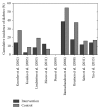
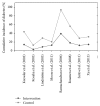
Similar articles
-
Diet, physical activity or both for prevention or delay of type 2 diabetes mellitus and its associated complications in people at increased risk of developing type 2 diabetes mellitus.Cochrane Database Syst Rev. 2017 Dec 4;12(12):CD003054. doi: 10.1002/14651858.CD003054.pub4. Cochrane Database Syst Rev. 2017. PMID: 29205264 Free PMC article.
-
Lifestyle interventions for the treatment of women with gestational diabetes.Cochrane Database Syst Rev. 2017 May 4;5(5):CD011970. doi: 10.1002/14651858.CD011970.pub2. Cochrane Database Syst Rev. 2017. PMID: 28472859 Free PMC article.
-
Dipeptidyl-peptidase (DPP)-4 inhibitors and glucagon-like peptide (GLP)-1 analogues for prevention or delay of type 2 diabetes mellitus and its associated complications in people at increased risk for the development of type 2 diabetes mellitus.Cochrane Database Syst Rev. 2017 May 10;5(5):CD012204. doi: 10.1002/14651858.CD012204.pub2. Cochrane Database Syst Rev. 2017. PMID: 28489279 Free PMC article.
-
Long-term non-pharmacological weight loss interventions for adults with prediabetes.Cochrane Database Syst Rev. 2005 Apr 18;(2):CD005270. doi: 10.1002/14651858.CD005270. Cochrane Database Syst Rev. 2005. PMID: 15846748
-
Impact of a community-based lifestyle intervention with initial sedentary reduction or physical activity increasing goals on self-reported health-related quality of life.Transl Behav Med. 2025 Jan 16;15(1):ibae076. doi: 10.1093/tbm/ibae076. Transl Behav Med. 2025. PMID: 39846989 Clinical Trial.
Cited by
-
TOTUM-63, a plant-based polyphenol-rich extract, improves glycaemic control in subjects with prediabetes or early stage newly-diagnosed type 2 diabetes in a randomized, double-blind, placebo-controlled trial.Diabetes Obes Metab. 2022 Dec;24(12):2331-2340. doi: 10.1111/dom.14817. Epub 2022 Aug 1. Diabetes Obes Metab. 2022. PMID: 35837981 Free PMC article. Clinical Trial.
-
Lifestyle Interventions to Promote Healthy Nutrition and Physical Activity in Middle-Age (40-60 Years) Adults: A Randomized Controlled Trial in the North of Iran.J Res Health Sci. 2019 Jan 9;19(1):e00434. J Res Health Sci. 2019. PMID: 31133624 Free PMC article. Clinical Trial.
-
Reduction in HbA1c with Exercise videogames among participants with elevated HbA1c: Secondary analysis of the Wii Heart Fitness trial.Diabetes Res Clin Pract. 2019 Aug;154:35-42. doi: 10.1016/j.diabres.2019.06.011. Epub 2019 Jun 22. Diabetes Res Clin Pract. 2019. PMID: 31238061 Free PMC article.
-
Lifestyle Modification Programs and Interventions on Prediabetes in Saudi Arabia: A Systematic Scoping Review.J Prev (2022). 2025 Aug;46(4):615-637. doi: 10.1007/s10935-025-00835-0. Epub 2025 Apr 11. J Prev (2022). 2025. PMID: 40216730
-
Frequency of impaired fasting glucose in first degree relatives of Type-II diabetic patients and its association with Body Mass Index.Pak J Med Sci. 2020 Mar-Apr;36(3):407-411. doi: 10.12669/pjms.36.3.57. Pak J Med Sci. 2020. PMID: 32292443 Free PMC article.
References
-
- Meetoo D. Diabetes: complications and the economic burden. British Journal of Health Care Management. 2014;20(2):60–67. doi: 10.12968/bjhc.2014.20.2.60. - DOI
-
- Health and Social Care Information Centre (HSCIC) Quality and Outcomes Framework Achievement, Prevalence and Exception Data, 2012/13. 2013. http://www.hscic.gov.uk/catalogue/PUB12262/qual-outc-fram-12-13-rep.pdf.
-
- Hex N., Bartlett C., Wright D., Taylor M., Varley D. Estimating the current and future costs of Type1 and Type2 diabetes in the UK, including direct health costs and indirect societal and productivity costs. Diabetic Medicine. 2012;29(7):855–862. doi: 10.1111/j.1464-5491.2012.03698.x. - DOI - PubMed
-
- Department of Health (DoH) Turning the Corner: Improving Diabetes Care. 2006. http://www.bipsolutions.com/docstore/pdf/13587.pdf.
Publication types
MeSH terms
Substances
LinkOut - more resources
Full Text Sources
Other Literature Sources
Medical

